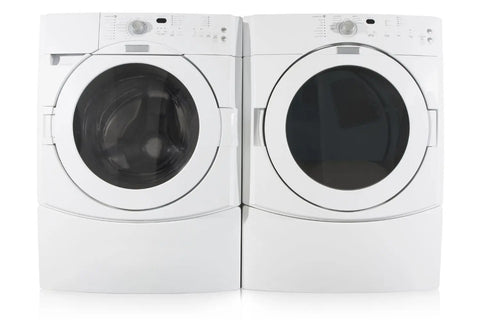
Spring Cleaning Your Workwear: Tips for Scrub Maintenance
Spring Cleaning Your Workwear: Tips for Scrub Maintenance
Spring has officially sprung! The flowers blooming, the tree buds are popping, and the weather is finally warm. It is lovely! Unfortunately, the sunshine flooding in the windows also tells us it’s time to clean our scrubs deep. Bodily fluids, bacteria, and even old lunch stains can leave your scrubs dingy.
No worries, though, because we’ve created this Best Scrub Care Tips guide.
Daily maintenance of your scrubs is straightforward. Depending on the fabric that your scrubs are created from, you can follow the fabric-specific washing instructions on the tag. If you would like to remove your tags, you can find some notes on practical workwear maintenance in our article, The Science of Comfort, What Makes Scrubs Truly Comfortable.
Now, we need to address work attire maintenance beyond everyday cleaning. A quick spin in the wash does the job for everyday messes, but you should re-evaluate your scrubs' health seasonally. First, are they holding up? If your scrubs are torn, tattered, or just plain gross, it's time for a new set. You’d be surprised how long you might have been wearing them. Years can pass before we realize that our scrubs are past their prime or outdated and unprofessional. If you’ve just realized it’s time for new scrubs but don’t know where to begin, we’ve got you covered. Our article on Choosing the Right Workwear for 2024 highlights the best styles for 2024.
Scrub Cleaning Tips:
Healthcare uniform care should focus on sanitation, regardless of where you work. While washing your scrubs according to the manufacturer’s directions and choosing antimicrobial fabrics helps, your scrubs still require scheduled sanitation. Several brands of laundry sanitizer are available, but extending your scrub's lifespan means looking for one without bleach. Bleach can remove color from your scrubs and break down the fibers over time, shortening the life of your uniforms. Add the recommended amount to the fabric softener bin or directly into the washer during the rinse cycle to use the sanitizer.
Don’t Forget Your Machine:
While we’re discussing sanitation, consider your washing machine. Have you been washing dirty scrubs in it all year, never giving it any attention? Your machine needs to be cleaned and sanitized as well. Start by giving your machine a scrubbing. Follow your machine’s instructions to clean the outside, and gently wipe down the exposed areas outside the drum. Also, follow the manufacturer’s instructions to empty the filter if your machine has one. The most crucial step is to use a good-quality washing machine sanitizer and run an empty cycle, choosing the washing or sanitizing cycle.

Choosing the Right Detergent for Scrub Uniforms:
What kind of laundry detergent do you use on your scrubs? Take a moment to consider your current wash routine and if it’s the best thing for your fabric. You invest your hard-earned money into your scrubs, and with proper care, they’ll last you a long time. If your detergent isn’t doing a great job or is causing your scrubs to break down, it’s time to find something new. When shopping for a new detergent, consider:
- Ingredient List
- Skin Sensitivities
- Machine Type
- Eco-Impact
- Detergent Type (Powder, Liquid, Pods, Sheets)
Ingredient List:
When choosing your detergent, ingredients matter. Unseen by the naked eye, most of what soils your workwear won’t be released without the right mix of surfactants and enzymes. If you’re noticing odors in your clothing, it’s likely a result of built-up bodily fluids. Look for detergents with a good mix of several “cases.” These liberate the oils and soils from your scrubs, leaving them truly clean. Examples include protease, mannanase, amylase, and pectate lyase.
Skin Sensitivities:
If your skin is sensitive, you may find that certain detergents leave you itchy or irritated. This is primarily a challenge for ladies when the reaction occurs in a most uncomfortable location. If you’ve ever experienced this kind of torture, you likely haven’t forgotten. Keep it in mind when choosing your next detergent, and look for something free of dyes and perfumes. You may also want to consider an all-natural alternative to dryer sheets, such as wool dryer balls.
Machine Type:
Your washing machine may influence your laundry detergent choice. While a wider variety of detergents is safe for older machines, newer, high-efficiency (HE) machines require specialized detergent. If you need an HE detergent, look for the HE symbol on your chosen product, and always use only the recommended amount with each wash. Using a non-HE product or too much detergent will produce more suds than the low-water washer can handle, leading it to run longer than it should or overflow.
Eco-Impact:
Suppose you want to reduce the amount of chemicals released into your home and the groundwater, decrease the amount of plastic waste you produce, and support eco-conscious companies. In that case, an eco-friendly detergent may be suitable for you. There are several unique brands to choose from. Tru Earth, Blueland, and Dropps, to name a few. These companies focus on adding all-natural substances to their detergent, leaving your clothing fresh and chemical-free.
Another eco-friendly option is Soap Nuts. Derived from a deciduous tree native to warm, frost-free regions, the “nut” is the tree’s berry. When added to water, the berry forms a foamy lather that works as an all-natural surfactant, removing oils and stains from your clothing. The one downfall to soap nuts is that while they are effective, they aren’t as powerful as a chemical compound when removing tough stains and odors.

Detergent Type:
As discussed, detergents are available in several forms, including powder, liquid, pods, sheets, and nuts. In part, the one you choose is based simply on preference. Liquid detergents are the most readily available and sold at most stores. They work well and are easy to measure. Unfortunately, they’re also heavy and create plastic waste.
Powder detergents are often packaged in cardboard, creating less waste. Unfortunately, many don’t like that there is usually leftover detergent that doesn’t dissolve in the machine.
Pods are also highly popular. They contain the same cleaning power as a liquid detergent in a pre-packaged, pretty little pod. Unfortunately, they’re a safety hazard for children and are not cost-effective.
Most recently, laundry detergent sheets have hit the market and are gaining popularity. The sheets are pre-measured and packaged in lightweight, eco-friendly, minimalistic packaging. While not widely available, they can be purchased online through several retailers.
Eco-Friendly Cleaning Solutions for Workwear:
We have touched on these briefly above, but it’s important to note that plenty of eco-friendly cleaning solutions for scrubs exist. If you’re using an all-natural detergent, consider its cleaning power. If you’re working a job that leaves you especially dirty, ensure the detergent contains enough natural surfactants and antimicrobial properties to clean your scrubs.
Preventing Shrinkage in Scrub Uniforms:
Investing in your work uniforms is about more than your original purchase. It’s also about maintaining your scrubs and ensuring they last, including preventing shrinkage.
Preventing shrinkage in your scrubs is primarily done by avoiding too much heat. Heat is the number one cause of shrinkage in uniforms. Avoid this by washing in cool or warm water and using proper drying methods for scrubs, such as low or no heat. If you’re concerned about sanitation, add laundry sanitizer, but keep the heat down.

Culinary Attire Cleaning Routine:
We see you if you’re not a healthcare worker, but instead, serve the world with your culinary skills! We know you have uniforms that take a beating, but you must show up clean and professional the next day. We have included these culinary attire-cleaning hacks just for you!
While many of the tips and tricks for cleaning healthcare scrubs will be helpful for you as well, we all know that food stains can sometimes be on another level. When dealing with food stains:
1. Avoid hot water. Heat can denature the proteins in the food stain and make removing them more difficult.
2. Address the stains quickly. Don’t let them sit until laundry day.
3. Pre-treat the stains with cool water and a quality laundry pre-treater.
4. Avoid bleach. Not only will it break down your uniform’s fibers, but it can also cause yellowing, making your uniform appear dingy.
5. Replace bleach with a laundry additive such as OxiClean.
6. For greasy stains, rub Dawn dish detergent into the paint, let it sit for several minutes, and wash it.
These stain-removal techniques will make you and your culinary uniforms look your best!
SCRUB PRO Uniforms: Two Decades of Excellence
You need new scrubs, and Scrub Pro has them! Both online and in-store, you’ll find an unbeatable selection with fast shipping, hassle-free returns and exchanges, and unsurpassed customer service.
Please find your nearest store: Check out our locations to find the closest store.
Shop online: Can’t make it to the store? Explore our entire collection from the comfort of your home at ScrubPro.com.

Tammy McKinney, a seasoned Registered Nurse, distinguished healthcare writer, and founder of HelpfulHospiceNurse.com, is committed to using her medical knowledge to educate, inform, and entertain healthcare workers and their patients. To connect with Tammy directly, check her out on LinkedIn.



